Introduction
Candle making has been a popular craft for centuries and is an activity enjoyed by people of all ages around the world. It can be a fun and creative hobby that allows you to express yourself and your artistic side. With the right supplies and instruction, people of any skill level can make beautiful candles of all shapes and sizes.
Candle making is a unique art form with many options available in terms of scents, colors, sizes, and shapes/styles. Popular candle styles include jar candles, votive candles, tealights, container candles, tapers (long skinny candles), column candles (large round ones), pillars (square or rounded) and more! Different waxes are also available depending on what type of candle you’d like to make such as Beeswax, soy wax, paraffin wax, palm wax and so on. There’s lots to learn about wick sizing too – this is an important component for ensuring your finished candle will burn properly. Additionally adding fragrances will give your candle a pleasant aroma when lit. Finally you can decorate with items such as glitter or natural botanicals like flower petals to create unique designs perfect for gifting or keeping.
As with many other hobbies there are tried-and-true techniques used by experts which takes practice – especially if you want to make professional looking products. Experienced candlers have often developed their skills through attending workshops or taking an online course from an experienced artisan. Many novice makers also look to blogs or Pinterest for inspiration on crafts they can recreate at home too!
History
Throughout the ages, candle making has served as a form of personal expression and illumination. In ancient times, when the sun set in places where electricity was missing or scarce, the only source of light was from an open fire or candles. Candles were made from various materials; tallow (animal fat) candles were common even before the time of Christ. Beeswax was also used in developing primitive candles since it made them nicer-smelling and easier to manipulate into intricate shapes.
Eventually, during Europe’s Medieval Age, candle-making techniques began to improve with better use of clay molds and metal containers. People would create figures such as stars and trees with their candles in Rome while using them as gifts on occasions like Christmas, Easter or birthdays. In 18th century England, additional innovations came up such as creating colored waxes by adding oil paints and other pigments to wax; wicking materials were also intertwined on poles to act as lightbulbs for homes lacking electricity.
The use of paraffin wax dates back to 1850; this type of wax is still used today for candle making. Paraffin allowed for larger and longer-burning candles that often had multiple wicks added in to create more light . During World War II beekeeping experienced a decline due to rationing and restrictions placed on German beeswax imports resulting in paraffin used increasingly in candle making until it became one of the most popular types available. Since then many other varieties have come out including soy wax, palm wax and beeswax blended with vegetable stearic acid designed not only to give a cleaner burn but also make pouring melted wax easier for artisans during crafting.
Supplies
Making candles can be a fun and rewarding hobby. There are a few essential items for candle making that any aspiring hobbyist should have in order to get started. Here is a list of supplies that you will need:
1. Wax: Choose from paraffin, soy, or beeswax depending on your preferences. Paraffin wax is the most widely used type of wax for making candles, but some people prefer soy or beeswax because these are natural options.
2. Molds: Candle molds come in different sizes and shapes to allow you to create unique shapes. Make sure the mold you choose is suited to the type of wax you’re using, as certain molds are not compatible with some types of waxes.
3. Wicks: Choose from metal core or cotton wicks depending on the size, shape, and material of your candle moulds. Always use pre-tabbed wicks for easy installation.
4. Melting Pot & Thermometer: You need a melting pot that can hold enough melted wax for your project and a thermometer to monitor and regulate the temperature when melting new batches of wax.
5. Dyes & Fragrances: Dyes and fragrances are optional but they can give your candles an interesting look and scent. Choose from liquid dyes or powdered pigments and find scented oils suitable for candle-making too! Make sure they are compatible with your chosen types of wax before beginning your project.
6. Safety Gear: Remember to wear gloves and protective goggles when handling melts wax! You don’t want to risk burning yourself with hot liquids or having them splatter into your eyes by accident!
Waxes
Waxes are one of the main components in candle making, and they have a variety of different strengths and uses. Paraffin wax is the most commonly used wax for making candles, as it typically gives the best results and is relatively easy to work with. Soy wax is also popular, as it’s eco-friendly and has great scent throw when burning. Beeswax has a slightly stronger scent throw but takes more time to work with. Gel wax is good for making container candles because it holds its shape while melting without producing any smoke or soot. Lastly, palm wax gives a beautiful crystallized finish, making it ideal for pillar candles. Each type of wax has its own unique benefits and drawbacks, so test out several types to determine which one works best for your candle project!
Scents and Color
When it comes to choosing scents and colors for your candles, the possibilities are endless! You can choose anything from a simple, neutral scent such as vanilla, to something fresh and citrus like orange or lemon. As for colors, you can opt for pure white, classic ivory, black, or even vibrant and eye-catching shades of red, blue or green. You can also mix several colors into one candle to come up with a unique design. If you plan on using essential oils to add scents to your candles, make sure they are natural and have been specifically made for candle making. Most candle suppliers will have a wide range of different scents and colors available in the store or online.
Interesting Facts About Candle Making
• The oldest known candles were made by the Romans around 500BC.
• Beeswax was one of the earliest known waxes used to make candles.
• Medieval European monks used beeswax to light their chapels, as it had a sweet smell and burned more slowly than tallow (animal) fat.
• In 17th century England, to charge tax on candles, they were marked with a symbol according to size and quality. It became known as a ‘candle mark’.
• Until the 19th century, most candlesticks were made from brass or iron.
• In 1820, Joseph Morgan introduced the first dipped candle machine in England-revolutionising candle making for centuries to come!
• By the 1900s, paraffin wax replaced beeswax as the primary wax for candle making and still remains so today.
• Candles made with metallic-dipped wicks that contain small amounts of zinc or lead offer increased stability of flame when compared to cotton or paper wick types do not recommend their usage because these metals are toxic!
Equipment
Candle making for fun can be a great way to unwind, get creative and explore something new. The most essential tools and materials for candle making for fun are wax, wicks, a double boiler (or a bain-marie), pouring pot, thermometer and molds. Wax is the main component in any candle creation- it provides fuel and gives the desired form. When working with wax it’s important to remember that applying direct heat can easily cause a fire hazard. A double boiler or bain-marie gives even heat when melting wax without the risk of an open flame. Pouring pots are essential tools that allow you to pour hot melted wax safely with precision into molds or other containers. A reliable candy thermometer will come in handy when monitoring the temperature of melted wax. Molds are used to shape the desired end product which can be anything from votives, pillars and tapers, to unique novelty shapes like card holders, flowerpots and animal figures. With some basic equipment one can establish their very own personal candle workshop!
Creative Decorating
Candle making is a great activity for anyone, whether you’re an experienced crafter or just dabble in arts and crafts now and then. Plus it can be really fun! Here are some candle making tips and techniques to get you started:
A) Wax Selection : Selecting the right type of wax for your project is essential. There are different types of wax such as paraffin, soy, beeswax, and more. Each wax has its own unique characteristics that may be more appropriate for certain projects than others. Do your research so you choose the right one for what you are trying to make!
B) Fragrance Selection : If you want to make scented candles, having a clear understanding of the fragrance notes you would like to use will help narrow down your choices significantly. Notes can range from floral to sweet, woody to citrus-y flavors – so test a few before deciding on which one or combination you want!
C) Dye Selection : You can purchase pre-colored candle waxes in bulk or add coloring pigment your own; both options will produce vibrant colors. Natural dye powders and liquid dye colors allow you craft unique blends ” any color imaginable is within reach using this method.
D) Wick Set Up: Wick sizes vary so experiment until you are able to find one that works best with your project; match the wick’s size with the diameter of the container and check if it stands straight when burning without moving around too much before making any successive batches in bulk. Additionally, pick up a few metal holders to keep them sturdy while crafting each piece.
E) Embellishing: Adding embellishments like glitter, herbs, nuts & bolts kits etc., adds extra character to any craft piece! Glitter particles give off beautiful sparkles while apples slices with cinnamon sticks create lovely fragrances depending on what effect you are going for. Design each candle uniquely by combining different items – get creative!
Advanced Candle Making
Candle making can be a great way to create unique and personalized gifts or something special for yourself. If you’re getting bored of basic candle styling, there are plenty of ways to level up your homemade candle game. Here are some advanced candle making techniques that you can explore:
1. Pillar Candle Making: Pillar candles offer a variety of shapes and sizes, so they are perfect for creating your signature designs. You’ll need different molds such as cubes or columns, specifically-formulated wax, wick tabs and wick bars, double boiler, thermometer and different colors if desired. Pillar candles take more time to make than container candles do but the end results will look very professional!
2. Float Candle Making: This is basically making containerless candles that flow on the surface of a bowl filled with water and/or oil for added effect. The upside is that there is no glass work in this method which makes things much easier. All you need for this project is wax chips, molds for shapes (a muffin pan will do just fine!), wicks with clips, dye colors and heat source like stove or hot plate.
3. Novelty Candle Making: If you want to go above and beyond when it comes to candlemaking why not try novelty candles? These types of candles require creative talent as well as skills in carving, sculpting and shaping various materials such as beeswax, paraffin wax or soap base into beautiful figurines like flowers or even cartoon inspired characters! Aside from candlemaking supplies listed above, you may also need materials such as sticks to work with wax sculptures and sheets of PVC plastic wrap to form free-flow figures.
Helpful Hints and Tricks
Candle making is a fun and rewarding craft that can produce beautiful, decorative candles in a variety of shapes, sizes, and colours. To get the most out of your candle making pursuits, there are some helpful hints and tricks to keep in mind. Firstly, make sure you use high-quality wax so your candles last for ages! Take the time to find the right-sized wick for your candle as this will affect how it will burn once lit. A good tip when creating multiple candles of similar size is to use a wax thermometer – this way you know the temperature is perfect throughout all your batches. Finally, ensure that when working with dyes or fragrances you don’t pour too much at once into your mix as this may cause your candles to produce strange odours or not burn correctly. Follow these simple tips and tricks and candle making will be an enjoyable experience every time!
Finishing Up
Candles can be used and enjoyed in many creative ways. Candles provide a pleasant fragrance throughout the home and make an excellent choice as gifts, décor, or both. One creative way to use candles is to create unique diffusers by filling various vessels with potpourri and adding scented wax chips or chunks. Candleholders will also add variety! Containers of varying sizes and materials can be filled with fragranced wax for a beautiful display piece that emits a wonderful aroma. Additionally, you can pair aromatic candles with personal items such as jewelry boxes, bookshelves, and desk spaces to add a bit of personality to any room. The options are literally endless when it comes to the enjoyable possibilities of candle making for fun!

Welcome to my candle making blog! In this blog, I will be sharing my tips and tricks for making candles. I will also be sharing some of my favorite recipes.



